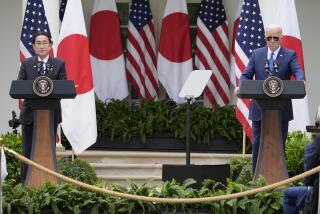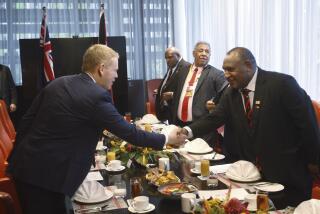Japan : A Security Treaty Best Suited for Another Era
- Share via
WASHINGTON — The rape of a 12-year-old Okinawan girl allegedly by three American servicemen has not only triggered outrage in Japan. It has also raised new--and legitimate--questions about the U.S. military presence in the country and the 44-year-old security treaty that governs it. Fifty years after Hiroshima and four years after the demise of the Soviet Union, the time has arrived to adjust the U.S.-Japan security relationship to fit a new era.
Military cooperation between the two countries remains robust. More than 20 joint training exercises are held annually; Japan pays the salaries of the 22,600 Japanese who work on U.S. bases, all utility costs, leases and much of the construction on the bases--about $5 billion a year. And it keeps its troop strength at 25th place in the world and stays non-nuclear.
After the rape case, Japanese public support for the security alliance has dropped, from 59.8% to 43.5%. Japanese increasingly wonder if they must continue to tolerate 59,000 American sailors (on shore half the time) airmen, soldiers and Marines living in their country.
Since 1952, U.S.-controlled facilities in Japan have been reduced by 97%, according to the Defense Department. But the United States still occupies more than 58,000 acres in Okinawa, about 20% of the 60-mile-long island, and about 78,000 acres in other parts of Japan. One reason is that when U.S. facilities are consolidated, and Japan requests that land be returned, the United States often insists on new land elsewhere. Defense Secretary William J. Perry’s offer last week to consider moving some troops and facilities out of Okinawa to other Japanese islands is a case in point. As a result, the United States has returned only 420 acres in Okinawa, and 460 acres in the rest of Japan, since 1984, numbers that hardly reflect a reassessment of Asian-Pacific threats since the Soviet collapse.
Also contributing to Japanese restiveness is their perception that the U.S.-Japan military relationship, including a Status of Forces Agreement that enabled the United States to retain custody of the three rape suspects until they were charged by a Japanese court, treats the host nation--an economic world power--as a junior partner. Clearly, a treaty that pledges both countries to “act to meet the common danger” if Japan (or U.S. forces stationed there) were attacked, but requires no similar Japanese response if the United States were hit, is unequal in its allocation of responsibilities.
Still, the treaty remains a remarkable document with enough built-in flexibility to adjust to a new era. There is room to reach a higher level of equality and joint responsibility. Consider:
* Military facilities. The United States needs a reality check on its base structure in Japan and on the external threats it may face in Asia. True, the Korean Peninsula remains a danger point, and China’s military buildup bears watching. And Japan agrees that the United States must maintain a credible military presence. But the United States cannot for long hold onto as much land as it still occupies without risking even more serious Japanese opposition. In consolidating more facilities, it must abstain from asking for new land when old land is returned to the Japanese.
“Joint use” of facilities with Japan’s Self-Defense Forces should also be carried farther. Even now, the two countries share runways, but more sharing is possible. For example, all U.S. pilots should land on, and become familiar with, Japanese air bases, and vice versa.
But “jointness” requires Japanese cooperation, too. Japan has been slow to respond to some plans to return its land. U.S. forces must be able to train, but this training would be more acceptable if it is carried out jointly with the Japanese. The Access and Cross-Servicing Agreement that Washington and Tokyo will sign next year will significantly improve mutual logistical support. Joint development of theater missile defenses, now under study, would add to the partnership.
* Peacekeeping . The Rising Sun will join the United Nation’s blue banner on the Golan Heights next year when Japan’s Self-Defense Forces replace a Canadian transportation unit. Already, Japan has contributed non-combat troops to the U.N. missions in Cambodia and Africa. But Japanese law severely restrains what Japan can do as a peacekeeper.
Japan would feel a greater sense of partnership with the United States and the United Nations if its Parliament lifted the restrictions, but its forces could even now train more with U.S. soldiers for such peacekeeping missions as disaster relief, refugee evacuation and accidents at sea. The security treaty provides sufficient authority to do so. In addition, nothing would more graphically signal Japan’s willingness to fulfill its potential to the United Nations than an offer to host a multilateral U.N. peacekeeping training center for East Asia, with faculty drawn from such veteran peacekeepers as Canada, Norway, Indonesia and Malaysia.
* Regional security cooperation . The treaty grants the United States use of military facilities in Japan not only for “the security of Japan” but also for “peace and security in the Far East,” a “common concern.” Japan’s soon-to-be-revised 1978 “guidelines” on defense cooperation with the United States devote only 14 lines to this increasingly important subject. The United States is also studying how the present treaty could be redefined to enable greater cooperation for regional stability.
But the people of Japan--and of neighboring countries--would not now support Japanese military activity beyond its borders unless the United States or the United Nations were its partner. Officer exchanges for training and consultation, ship visits, participation in multicountry seminars and inviting observers from neighboring countries to watch exercises are about the only acceptable ways that Japan can cooperate in regional security. But these could gradually be stepped up.
When President Bill Clinton and Japanese Prime Minister Tomiichi Murayama meet later this month, they should agree on more than a modification of who should have custody of Americans suspected of criminal behavior or where some U.S. troops in Okinawa might be relocated elsewhere in Japan. Instead, Clinton should declare America’s intention to maintain--throughout the country--only those forces and facilities essential to maintaining its credibility in a less threatening world. Some gradual scaling-back should be possible. Both leaders, meantime, should pledge their efforts to create a more equal and cooperative joint defense structure, with emphasis on peacekeeping and regional stability.
As unfortunate as the events in Okinawa are, they could stimulate a leaner, more up-to-date security relationship between two great powers, thereby ushering in a new era of joint cooperation embraced, not only by the Japanese, but by Americans as well.
More to Read
Sign up for Essential California
The most important California stories and recommendations in your inbox every morning.
You may occasionally receive promotional content from the Los Angeles Times.













